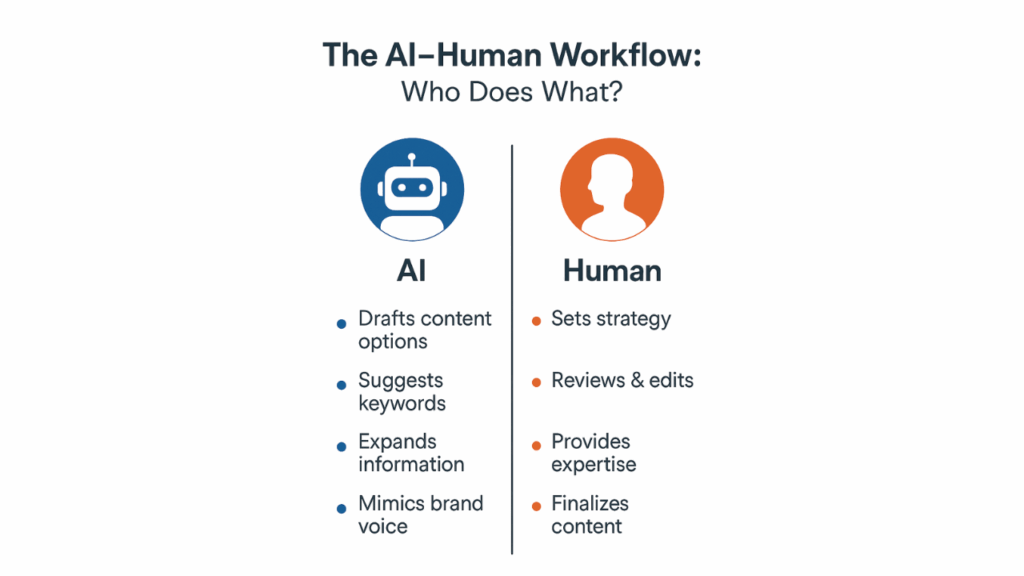For centuries, creativity has been seen as a uniquely human strength, rooted in emotion, lived experience, and the ability to tell compelling stories. But as artificial intelligence continues to evolve, that line between human and machine-driven creativity is beginning to blur. Today, AI is not just helping humans write, it’s producing content across formats: emails, blog articles, ad copy, social posts, video scripts, and more. The question is no longer if AI can write. The question is: Can it create meaningfully?
This blog explores how businesses are integrating AI into content creation workflows, where it performs best, and what happens when humans and machines co-create. We’ll cover everything from brand consistency and content scale to SEO performance and creative control.
What Creativity Means in Content Today?
Before deciding whether AI can create, we need to clarify what “creative content” actually is in today’s context.
Traditionally, creativity was about originality and emotional depth. A compelling piece of content required not just words, but intent, tone, nuance, and storytelling, a distinctly human skill set.
But in the digital content economy, creativity is also about:
- Delivering value at the right time.
- Resonating with segmented audiences.
- Staying on-brand across platforms.
- Testing, learning, and iterating faster than ever.
This redefinition is important because AI doesn’t need to “feel” creative in the human sense. It just needs to generate content that performs creatively, achieving relevance, engagement, and ROI.
What AI Excels At in Content Creation?
Before diving into deeper topics, it’s worth visualizing the creative spectrum and where AI fits in. Creativity spans from replication to original ideation, and AI, while not yet emotionally expressive, is exceptional at the recombinative middle of that spectrum.
AI’s content strengths include:
- Remixing styles based on tone prompts.
- Generating dozens of variations at speed.
- Maintaining structure and formatting across outputs.
- Drawing from massive language patterns and topic models.
This isn’t intuition, but it is operational creativity at scale.
Achieving Brand Consistency with AI
Brand storytelling thrives on consistency of tone, vocabulary, values, and visual identity. But as businesses grow across geographies and channels, maintaining that consistency manually is nearly impossible.
This is where AI shines:
- Trained on previous brand assets, AI can replicate preferred tones (playful, authoritative, warm, minimalist, etc.) across all new content.
- Prompt engineering ensures headlines, descriptions, CTAs, and even error messages all “sound” like the brand.
- AI can enforce vocabulary rules and brand voice guidelines automatically, something even the best human writers struggle with over hundreds of deliverables.
The result? Every campaign, email, product description, and push notification stays aligned, without a creative bottleneck.
Personalization at Scale
One-size-fits-all content no longer performs. Consumers expect experiences that feel tailored to their behavior, location, preferences, and stage in the buyer journey.
But humans can’t manually write 500 product descriptions for 10 different personas.
AI enables this by:
- Generating copy variations dynamically based on user data.
- Localizing tone, language, and references for different regions.
- Creating multi-layered content (like email flows or blog versions) based on intent signals.
For example, a fitness brand can instantly produce different copy styles for beginners vs. competitive athletes, each aligned with its core brand identity. Multiply that across SKUs, campaigns, and channels, and the content challenge becomes a scale opportunity.
AI vs. Traditional Writers: Who Does SEO Better?
Search Engine Optimization (SEO) is one of the most measurable battlegrounds for content performance. It’s also where AI has started to outperform traditional content teams in specific areas.
What AI does better:
- Keyword optimization: Models can ingest target keywords and generate semantically rich content in minutes.
- Internal linking and structure: AI can format content with optimized subheadings, bullets, and metadata.
- Topic coverage: It ensures breadth and depth based on current SERP trends and topical authority.
But here’s the nuance: AI gets you to first draft instantly. Human editors are still crucial for:
- Validating facts.
- Refining tone.
- Adding unique perspectives.
- Injecting lived experience or real-world analogies.
Together, AI and human writers form an agile SEO team, one that learns, adapts, and scales better than either alone. But SEO is just one part of a broader shift in how content is created and scaled. As the demands on brand teams grow, the question isn’t whether AI can write, it’s whether humans can keep up without it.
Human vs. AI Content Abilities: A Tactical Comparison
| Capability | Human Writer | AI Content Generator | Best Use Case |
| Emotional Resonance | High | Low–Medium | Long-form storytelling, brand manifestos |
| Speed & Volume | Medium | Very High | Product descriptions, headlines, A/B copy |
| SEO Optimization | High (with effort) | High (automated) | Listicles, FAQs, blog outlines |
| Personalization | Limited (manual effort) | High (data-driven) | Email campaigns, landing pages |
| Consistency | Variable (mood, style) | Very High | Multichannel brand messaging |
| Originality | High (subjective) | Low–Medium (recombinative) | Thought leadership, opinion pieces |
This makes it clear: AI thrives in structure, speed, and consistency. Humans shine in originality, emotion, and nuance. Together, they cover the entire creative spectrum more effectively than either can alone.
Real-World Use Cases of AI-Human Co-Creation
AI-powered content isn’t just theory, it’s already transforming workflows in leading organizations across industries. Here are a few real examples of how brands are blending machine efficiency with human creativity to drive results:

1. The Washington Post: Automated News with Heliograf
The Washington Post uses AI to generate short news reports, sports updates, and election result summaries. During the 2016 U.S. elections, AI tools produced over 850 articles, freeing up journalists to focus on deeper reporting.
AI Role: Generate data-driven stories at scale
Human Role: Investigate and write in-depth features
Outcome: Faster coverage, more newsroom productivity, and greater reach
2. Sephora: Personalized Email Marketing at Scale
Beauty retailer Sephora leverages AI to create highly personalized email campaigns. Their system uses customer data (past purchases, browsing behavior, preferences) to generate tailored product suggestions and dynamic content.
AI Role: Generate custom recommendations and copy variants
Human Role: Approve visuals, oversee tone, and refine promotional strategy
Outcome: Higher engagement and increased conversions through personalization
3. Nestlé: Global Multilingual Content Creation
Nestlé uses generative AI tools to create and localize content across 40+ markets and languages. Their marketing teams feed brand tone and campaign briefs into AI models, which then produce region-specific blog posts, social copy, and ads.
AI Role: Multilingual copy generation with tone consistency
Human Role: Final QA, cultural adaptation, and message refinement
Outcome: Reduced time-to-market and consistent global branding
These examples show that AI isn’t replacing creative teams, it’s augmenting them. From journalism and retail to global branding, the winning formula is clear: let AI handle scale and structure, while humans focus on strategy, culture, and creativity.
Why Content at Scale Requires Machines?
Modern content demands are unlike anything from the past decade. Brands today must deliver:
- Multilingual support.
- Personalized journeys.
- A/B tested variations.
- Evergreen and trend-reactive content.
- Cross-channel consistency.
The reality? Humans alone can’t meet that demand without burnout or skyrocketing costs.
AI enables a new workflow:
- Human sets the strategy, audience, and tone.
- AI drafts options instantly.
- Human filters, refines, and deploys.
- Performance feedback loops improve future prompts.
This co-creation doesn’t remove creative control, it amplifies human decision-making.
To see how this balance plays out in real workflows, here’s a quick breakdown of who does what when humans and AI collaborate on content creation:

Content Governance in the Age of AI
With AI generating hundreds of assets per week, content governance becomes crucial.
Best practices include:
- Creating brand style systems as prompts for consistent tone.
- Using moderation layers to flag hallucinated or off-brand content.
- Building approval workflows where AI outputs are reviewed by editors or legal teams.
- Maintaining a single source of truth for brand rules and persona definitions.
Think of AI as a high-speed content producer that still needs human QA. The efficiency gains are immense, but only if there’s governance in place to keep quality intact.
The Hidden ROI: Time Saved = Strategy Gained
One of the most underrated outcomes of AI-powered content is strategic bandwidth. When writers and designers are no longer buried under repetitive briefs and last-minute copy tweaks, they can focus on:
- Deep audience research.
- Creative campaign ideation.
- Long-form storytelling.
- Experimenting with new formats (video, motion graphics, etc.).
In other words, the true ROI isn’t just faster content. It’s better content born from reclaimed creative time.
Conclusion: Creativity Isn’t Dead – It’s Evolving
So, can AI be creative? Not in the way humans are, it doesn’t feel, dream, or intuit. But it can generate content at speed, remix ideas with precision, and co-create with humans in ways that redefine how creativity works in the digital age. The most effective content teams aren’t choosing between human or machine; they’re building workflows where AI handles the heavy lifting and humans bring the emotional depth, strategic thinking, and storytelling magic. Together, they’re delivering content that’s not only faster and more scalable but also more relevant, resonant, and real.At NoCrew, we help teams unlock this collaboration, training AI to execute your brand voice at scale while keeping humans at the center of strategy and storytelling. Get in touch with us.


